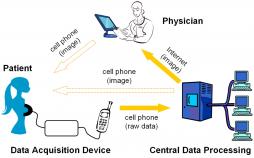Medical imaging has revolutionized western medicine in the past two decades, with the frontiers being constantly pushed to allow better, earlier and faster diagnosis for a variety of diseases. The story is quite different, however, in the developing world where, according to recent WHO estimates, over 50% of medical equipment that is available is not being used because it is too sophisticated or in disrepair or because the health personnel are not trained to use it. WHO further estimates that some three quarters of the world population does not have access to medical imaging.
One problem that may be at least partially responsible for this discrepancy is that typical medical imaging equipment is large, non-portable, expensive, require multiple components to work in concert (data acquisition, data analysis, image rendering and visual display), and require highly trained personnel to operate them optimally.
A collaborative group of researchers based at the University of California at Berkeley and at the Hebrew University in Jerusalem have come up with an ingenious solution to this intractable problem. These authors propose that one reason why medical imaging equipment are typically so expensive and complicated to use is that they are designed to be self-contained units that combine all aspects of imaging, namely: (a) the data acquisition hardware which is in contact with the patient, (b) the imaging processing hardware and software, and (b) the image display unit. This causes substantial duplication in expensive components and places increased demands on operator training.
To make medical imaging feasible in regions of the world with minimal infrastructure, the authors propose to decentralize the different aspects of medical imaging, and generate a new medical imaging system made of two independent components connected through cellular phone technology, ubiquitously available even in the remotest parts of the globe.
The independent units of this proposed decentralized imaging system are: (a) a data acquisition device (DAD) at a remote patient site that is simple, with limited controls and no image display capability, and (b) an advanced image reconstruction and hardware control multiserver unit at a central site. The vision is that cellular phone technology will transmit unprocessed raw data from the patient site DAD. These will then be processed at a central location, which can have cutting edge image processing and rendering equipment and algorithms. Furthermore, being located at one or a few central site(s), they can be easily upgraded and kept current with the world standards. The final rendered images will then be sent back to the patient site via cell phone, where they can be displayed and reviewed. Of course, this format will also be accessible to real time expert consultation via “conventional” telemedicine.
In this initial report, the authors have confirmed the feasibility of this concept both for diagnostic as well as interventional imaging, by using a laboratory model of human breast cancer.
The next step in the journey, of course, will be to work out the logistics of getting such a system to work in the field. However, it is a great beginning, and this commentator surely hopes that this approach can be translated to real world public health scenarios in the near future.


Post new comment